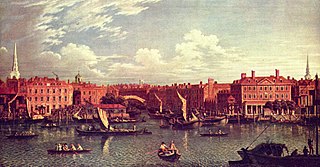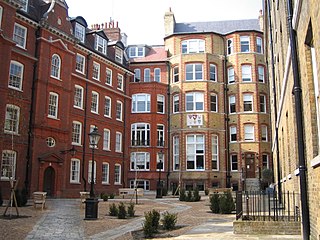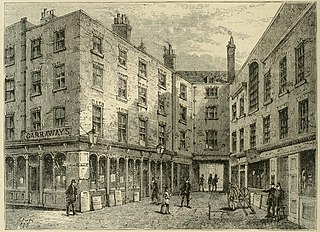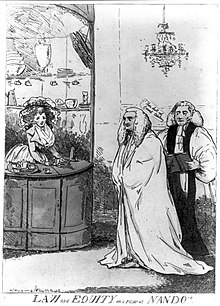
The River Fleet is the largest of London's subterranean rivers, all of which today contain foul water for treatment. It has been used as a sewer since the development of Joseph Bazalgette's London sewer system in the mid 19th century with the water being treated at Beckton Sewage Treatment Works. Its headwaters are two streams on Hampstead Heath, each of which was dammed into a series of ponds—the Hampstead Ponds and the Highgate Ponds—in the 18th century. At the southern edge of Hampstead Heath these descend underground as sewers and join in Camden Town. The waters flow 4 miles (6 km) from the ponds.

The Honourable Society of the Middle Temple, commonly known simply as Middle Temple, is one of the four Inns of Court exclusively entitled to call their members to the English Bar as barristers, the others being the Inner Temple, Gray's Inn and Lincoln's Inn. It is located in the wider Temple area of London, near the Royal Courts of Justice, and within the City of London. As a liberty, it functions largely as an independent local government authority.

The Honourable Society of the Inner Temple, commonly known as the Inner Temple, is one of the four Inns of Court and is a professional association for barristers and judges. To be called to the Bar and practise as a barrister in England and Wales, a person must belong to one of these Inns. It is located in the wider Temple area, near the Royal Courts of Justice, and within the City of London. As a liberty, it functions largely as an independent local government authority.

Fleet Street is a major street mostly in the City of London. It runs west to east from Temple Bar at the boundary with the City of Westminster to Ludgate Circus at the site of the London Wall and the River Fleet from which the street was named.

Ludgate Hill is a street and surrounding area, on a small hill in the City of London. The street passes through the former site of Ludgate, a city gate that was demolished – along with a gaol attached to it – in 1760.

Old Compton Street is a road that runs east–west through Soho in the West End of London.

Temple Bar is a building that was until 1878 the principal ceremonial entrance to the City of London from the City of Westminster; since relocated, it is today the home of the Worshipful Company of Chartered Architects and an education centre focused on architecture and heritage in the City of London.

The Great Conduit was a man-made underground channel in London, England, which brought drinking water from the Tyburn to Cheapside in the City.

Serjeant's Inn was the legal inn of the Serjeants-at-Law in London. Originally there were two separate societies of Serjeants-at-law: the Fleet Street inn dated from 1443 and the Chancery Lane inn dated from 1416. In 1730, the Fleet Street lease was not renewed and the two societies merged. The society's relevance diminished as Serjeants-at-Law were gradually superseded by Queen's Counsel in the nineteenth century. The building in Chancery Lane was sold in 1877 and the assets were distributed amongst the surviving members, although the society was not formally dissolved. The last member, Lord Lindley, died in 1921. The Fleet Street building was destroyed in the 1941 bombing raids during World War II.

The Church of St Andrew, Holborn, is a Church of England church on the northwestern edge of the City of London, on Holborn within the Ward of Farringdon Without.

The Grecian Coffee House was a coffee house, first established in about 1665 at Wapping Old Stairs in London, England, by a Greek former mariner called George Constantine.

St George the Martyr Holborn is an Anglican church located at the south end of Queen Square, Holborn, in the London Borough of Camden. It is dedicated to Saint George, and was originally so-called to distinguish it from the later nearby church of St. George's Bloomsbury, with which it shared a burial ground. While the historical name remains its formal designation, it is today known simply as St George's Holborn.

Lamb's Conduit Street is a street in Holborn in the West End of London. The street takes its name from Lambs Conduit, originally known as the Holborn Conduit, a dam across a tributary of the River Fleet.

The Bell Savage Inn was a public house in London, England, from the 15th century to 1873, originally located on the north side of what is now Ludgate Hill, in the City of London. It was a playhouse during the Elizabethan Era, as well as a venue for various other entertainments. It was also an important coaching inn. Other names by which it has been known throughout history include: Savage's Inn, The Bel Savage, Belle Savage, Belle Sauvage, Bell on the Hoop, Old Bell Savage, Belly Savage and others.

Pump Court is a courtyard in Temple, London, now primarily housing barristers' chambers. It is the first on the left in Middle Temple Lane from 6 Fleet Street, leading to Inner Temple Lane and Lamb's Buildings. Its name referred to the pump in the middle.
The Rainbow Coffee House was a famous coffee house located at 15 Fleet Street, London. It was opened by James Farr in 1657, becoming London's second coffee house.

The Grosvenor Gallery Library was a circulating library in London in the late 19th century. It was affiliated with the Grosvenor Gallery of art on Bond Street, later moving to South Molton Street. It offered subscribers current periodicals, new books, and a Ladies' Reading Room. Owners and staff included Miss Brinstingl, Coutts Lindsay, Mrs. A.W. Pollard, and Thomas Verrinder.

Garraways Coffee House was a London coffee house in Exchange Alley from the period where such houses served as important places where other business was performed. Its original proprietor, Thomas Garway, was already said to be the first person in England to sell tea prior to the house's founding, and when he began to sell it here in 1657 it became the first place in England to do so. The Hudson's Bay Company conducted its first sale of furs at the coffee house in 1671.

The Lamb and Flag is a Grade II listed public house at Rose Street, Covent Garden, London, WC2.

The City of London Tavern or London Tavern was a notable meeting place in London during the 18th and 19th centuries. A place of business where people gathered to drink alcoholic beverages and be served food, the tavern was situated in Bishopsgate in the City of London. The original tavern was destroyed in a fire on 7 November 1765 and the new building was designed by William Jupp the elder and opened in September 1768. In 1828, the proprietor was Charles Bleaden. The building was demolished in 1876. The tavern boasted a large and well-decorated dining room with Corinthian columns. It hosted numerous public and private meetings held to rally support to various political, charitable and other causes.



















